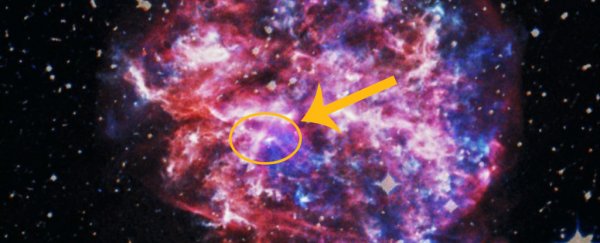When massive stars die, they don't do so quietly.
Their deaths are spectacularly brilliant affairs that light up the cosmos, a supernova explosion that sends star guts punching out into space in a cloud of splendor. Meanwhile, the core of the star-that-was can linger on, collapsed into an ultra-dense neutron star or black hole.
If that explosion takes place in a certain way, it can send the collapsed core barreling across the Milky Way like a bat out of hell, at such insane velocities they can eventually punch clean out of the galaxy altogether, on a wild journey into intergalactic space.
It's one of these objects that has been newly measured via data from the Chandra X-ray observatory: a type of pulsing neutron star known as a pulsar, ripping through its own entrails at a speed of around 612 kilometers per second (or 1.4 million miles per hour).
It's one of the fastest objects of this kind ever detected. (The fastest known star in the Milky Way is not a supernova remnant that has been kicked by an explosion, but a star orbiting Sgr A*, the supermassive black hole in the galactic center. At the fastest point in its orbit, it moves at a wild 24,000 kilometers per second.)
"We directly saw motion of the pulsar in X-rays, something we could only do with Chandra's very sharp vision," said astrophysicist Xi Long of the Harvard & Smithsonian Center for Astrophysics (CfA).
"Because it is so distant, we had to measure the equivalent of the width of a quarter about 15 miles away to see this motion."
The detection was made by looking at a glowing supernova remnant some 20,000 light-years away, named G292.0+1.8. Previous observations had revealed a speeding pulsar therein. Long and his colleagues wanted to study the object to see if it could reveal the history of the supernova, by tracing its motion to the center of the object in reverse.
"We only have a handful of supernova explosions that also have a reliable historical record tied to them," said astrophysicist Daniel Patnaude of the CfA, "so we wanted to check if G292.0+1.8 could be added to this group."
They studied images taken of the supernova remnant in 2006 and 2016, and used Gaia data on its current location in the Milky Way, comparing the differences in the pulsar's position. These comparisons revealed something extremely interesting: The dead star appears to be moving 30 percent faster than previous estimates had suggested.
This means it has taken a much shorter time to travel from the center of the supernova remnant, suggesting the supernova itself took place much more recently. Previous estimates put the date of the supernova at around 3,000 years ago; the new estimates take it to around 2,000 years ago.
The revised velocity of the pulsar also allowed the team to conduct a new, detailed investigation into how the dead star might have been ejected from the center of the supernova. They came up with two scenarios, both involving a similar mechanism.
In the first, neutrinos are ejected from the supernova explosion asymmetrically. In the other, debris from the explosion is ejected asymmetrically. However, because the neutrino energy would need to be extremely large, the more likely explanation is asymmetrical debris.
Basically, a lopsided explosion can 'kick' the collapsed core of a dead star out into space at extremely high speeds; in this case, the star is currently traveling at a speed higher than the Milky Way mid-disk escape velocity of 550 kilometers per second, although it will take quite some time to get there, and it may slow down over time.
In fact, its true speed may be even higher than 612 kilometers per second, because it is traveling very slightly along our line of sight.
"This pulsar is about 200 million times more energetic than Earth's motion around the Sun," said astrophysicist Paul Plucinsky of CfA. "It appears to have received its powerful kick just because the supernova explosion was asymmetric."
The team's research, presented at the 240th meeting of the American Astronomical Society, has been accepted into The Astrophysical Journal and is available on arXiv.
